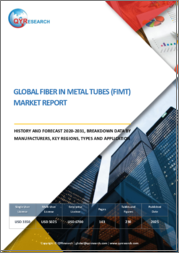
|
시장보고서
상품코드
1628152
풍력 터빈 블레이드 피뢰용 확장 금속 포일 시장 기회, 성장 촉진요인, 산업 동향 분석, 예측(2025-2034년)Expanded Metal Foils Market for Wind Turbine Blades Lightning Protection Opportunity, Growth Drivers, Industry Trend Analysis, and Forecast 2025 - 2034 |
||||||
2024년 풍력 터빈 블레이드 피뢰용 확장 금속 포일 세계 시장 규모는 6억 640만 달러에 달했습니다.
이 시장은 재생에너지, 특히 풍력발전으로의 전환으로 인해 2025년부터 2034년까지 연평균 8.3%의 성장률을 기록할 것으로 예상됩니다. 세계 풍력에너지 부문이 성장함에 따라 터빈 블레이드의 내구성과 안전성을 높이는 것이 시급한 과제입니다. 확장된 금속 호일은 블레이드 표면에 낙뢰를 효율적으로 분산시켜 잠재적인 손상을 최소화함으로써 이러한 측면에서 중요한 역할을 합니다. 재료 기술의 발전으로 이러한 호일은 더욱 효율적이고 비용 효율적이 되어 재생에너지 분야에서의 채택을 더욱 촉진하고 있습니다. 규제 의무와 환경 보호에 대한 관심도 기업들이 혁신적인 낙뢰 보호 솔루션에 투자하도록 유도하고 있습니다.
시장은 풍력 터빈의 종류에 따라 구분되며, 주로 수평축 터빈과 수직축 터빈으로 나뉩니다. 수평축 터빈은 2024년 5억 3,810만 달러의 매출로 시장을 주도할 것이며, 2034년에는 12억 달러를 넘어설 것으로 예상됩니다. 이러한 우위는 우수한 에너지 효율과 낮은 에너지 생산 비용에 기인합니다. 이러한 터빈은 일반적으로 다양한 용량을 제공하므로 다양한 에너지 요구 사항에 적합합니다. 이 터빈의 출력은 크기와 설치 장소의 풍황에 따라 크게 좌우되기 때문에 대규모 풍력발전 프로젝트에서 인기를 얻고 있습니다.
미국의 풍력 터빈 블레이드 피뢰용 확장 금속 포일 시장은 2024년 8,120만 달러로 평가되었습니다. 북미 시장은 재생에너지 인프라 확대에 대한 강력한 노력으로 인해 급속한 성장세를 보이고 있습니다. 청정에너지 도입을 촉진하기 위한 정부의 노력으로 풍력발전소 개발이 크게 가속화되면서 고급 낙뢰 보호 시스템에 대한 수요가 증가하고 있습니다. 특히 해안 지역에서 해상 풍력발전 프로젝트가 증가함에 따라 확장 금속 포일과 같은 신뢰할 수 있고 비용 효율적인 재료에 대한 필요성이 더욱 커지고 있습니다.
| 시장 범위 | |
|---|---|
| 시작 연도 | 2024년 |
| 예측 연도 | 2025-2034년 |
| 시작 금액 | 6억 640만 달러 |
| 예상 금액 | 14억 달러 |
| CAGR | 8.3% |
풍력 터빈 설계 및 재료 과학의 기술 발전도 북미 시장의 성장을 촉진하고 있습니다. 개발업체들은 터빈의 성능을 향상시키고 유지보수 필요성을 줄이기 위해 더 가볍고 내구성이 뛰어난 포일 개발에 주력하고 있습니다. 또한, 이 지역의 규제 환경은 엄격한 안전 및 성능 표준을 강조하고 있으며, 기업들은 규정 준수를 위해 첨단 솔루션을 채택하고 있습니다. 이러한 기술 혁신과 효율성에 대한 관심은 향후 몇 년 동안 시장 성장 궤도를 유지할 것으로 예상됩니다.
목차
제1장 조사 방법과 조사 범위
제2장 주요 요약
제3장 업계 인사이트
- 생태계 분석
- 밸류체인에 영향을 미치는 요인
- 이익률 분석
- 파괴
- 향후 전망
- 제조업체
- 유통업체
- 공급업체 상황
- 이익률 분석
- 주요 뉴스
- 규제 상황
- 영향요인
- 성장 촉진요인
- 청정에너지 생산의 풍력 터빈 이용 확대
- 지속가능한 에너지 자원으로서 풍력 터빈 이용을 촉진하는 정부 정책
- 업계의 잠재적 리스크와 과제
- 풍력 터빈에 의한 소음과 진동
- 성장 촉진요인
- 성장 가능성 분석
- Porters 분석
- PESTEL 분석
제4장 경쟁 구도
- 소개
- 기업 점유율 분석
- 경쟁 포지셔닝 매트릭스
- 전략 전망 매트릭스
제5장 시장 규모 및 예측 : 풍력 터빈 유형별, 2021-2034년
- 주요 동향
- 수평축
- 수직축
제6장 시장 규모 및 예측 : 지역별, 2021-2034년
- 주요 동향
- 북미
- 미국
- 캐나다
- 유럽
- 영국
- 독일
- 프랑스
- 이탈리아
- 스페인
- 러시아
- 아시아태평양
- 중국
- 인도
- 일본
- 한국
- 호주
- 라틴아메리카
- 브라질
- 멕시코
- 중동 및 아프리카
- 남아프리카공화국
- 사우디아라비아
- 아랍에미리트
제7장 기업 개요
- Alabama Metal Industries
- CThru Metals
- Dexmet
- New Metals
- Niles International
- Wallner Expac
- Yilida Metal Wire Mesh
The Global Expanded Metal Foils Market for Wind Turbine Blades Lightning Protection was valued at USD 606.4 million in 2024. The market is projected to expand at a CAGR of 8.3% from 2025 to 2034, driven by the increasing shift toward renewable energy sources, particularly wind power. As the global wind energy sector grows, there is a pressing need to enhance the durability and safety of turbine blades. Expanded metal foils play a critical role in this regard by efficiently dispersing lightning strikes across the blade surface, minimizing potential damage. Advances in material technology have made these foils more efficient and cost-effective, further encouraging their adoption in the renewable energy sector. Regulatory mandates and environmental concerns also push companies to invest in innovative lightning protection solutions.
The market is segmented based on wind turbine types, primarily horizontal-axis and vertical-axis turbines. Horizontal-axis turbines led the market in 2024, accounting for USD 538.1 million in revenue, and are anticipated to surpass USD 1.2 billion by 2034. This dominance is attributed to their superior energy efficiency and lower cost of energy production. These turbines typically offer a wide range of capacities, making them suitable for diverse energy requirements. The power output of these turbines depends significantly on their size and the wind conditions at their location, contributing to their popularity in large-scale wind energy projects.
In the United States, the expanded metal foils market for wind turbine blades lightning protection was valued at USD 81.2 million in 2024. The market in North America is experiencing rapid growth, driven by a strong commitment to expanding renewable energy infrastructure. Government initiatives aimed at boosting clean energy adoption have significantly accelerated the development of wind farms, creating a growing demand for advanced lightning protection systems. The rise of offshore wind projects, particularly in coastal regions, further fuels the need for reliable and cost-effective materials like expanded metal foils.
| Market Scope | |
|---|---|
| Start Year | 2024 |
| Forecast Year | 2025-2034 |
| Start Value | $606.4 Million |
| Forecast Value | $1.4 Billion |
| CAGR | 8.3% |
Technological progress in wind turbine design and materials science is also driving market growth in North America. Manufacturers are focusing on developing lighter, more durable foils to enhance turbine performance and reduce maintenance needs. Additionally, the region's regulatory landscape emphasizes strict safety and performance standards, compelling companies to adopt advanced solutions to ensure compliance. This focus on innovation and efficiency is expected to sustain the market's growth trajectory in the coming years.
Table of Contents
Chapter 1 Methodology & Scope
- 1.1 Market scope & definition
- 1.2 Base estimates & calculations
- 1.3 Forecast calculation
- 1.4 Data sources
- 1.4.1 Primary
- 1.4.2 Secondary
- 1.4.2.1 Paid sources
- 1.4.2.2 Public sources
Chapter 2 Executive Summary
- 2.1 Industry synopsis, 2021-2034
Chapter 3 Industry Insights
- 3.1 Industry ecosystem analysis
- 3.1.1 Factor affecting the value chain
- 3.1.2 Profit margin analysis
- 3.1.3 Disruptions
- 3.1.4 Future outlook
- 3.1.5 Manufacturers
- 3.1.6 Distributors
- 3.2 Supplier landscape
- 3.3 Profit margin analysis
- 3.4 Key news & initiatives
- 3.5 Regulatory landscape
- 3.6 Impact forces
- 3.6.1 Growth drivers
- 3.6.1.1 Growing use of wind turbines for clean energy production
- 3.6.1.2 Government policies promoting the use of wind turbines as a sustainable energy resource
- 3.6.2 Industry pitfalls & challenges
- 3.6.2.1 Noise and vibration caused by wind turbine
- 3.6.1 Growth drivers
- 3.7 Growth potential analysis
- 3.8 Porter's analysis
- 3.9 PESTEL analysis
Chapter 4 Competitive Landscape, 2024
- 4.1 Introduction
- 4.2 Company market share analysis
- 4.3 Competitive positioning matrix
- 4.4 Strategic outlook matrix
Chapter 5 Market Size and Forecast, By Wind Turbine Type, 2021-2034 (USD Million)
- 5.1 Key trends
- 5.2 Horizontal axis
- 5.3 Vertical axis
Chapter 6 Market Size and Forecast, By Region, 2021-2034 (USD Million)
- 6.1 Key trends
- 6.2 North America
- 6.2.1 U.S.
- 6.2.2 Canada
- 6.3 Europe
- 6.3.1 UK
- 6.3.2 Germany
- 6.3.3 France
- 6.3.4 Italy
- 6.3.5 Spain
- 6.3.6 Russia
- 6.4 Asia Pacific
- 6.4.1 China
- 6.4.2 India
- 6.4.3 Japan
- 6.4.4 South Korea
- 6.4.5 Australia
- 6.5 Latin America
- 6.5.1 Brazil
- 6.5.2 Mexico
- 6.6 MEA
- 6.6.1 South Africa
- 6.6.2 Saudi Arabia
- 6.6.3 UAE
Chapter 7 Company Profiles
- 7.1 Alabama Metal Industries
- 7.2 CThru Metals
- 7.3 Dexmet
- 7.4 New Metals
- 7.5 Niles International
- 7.6 Wallner Expac
- 7.7 Yilida Metal Wire Mesh



















